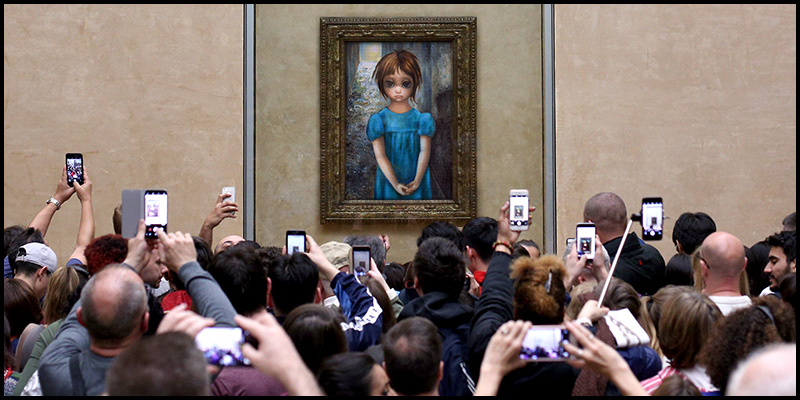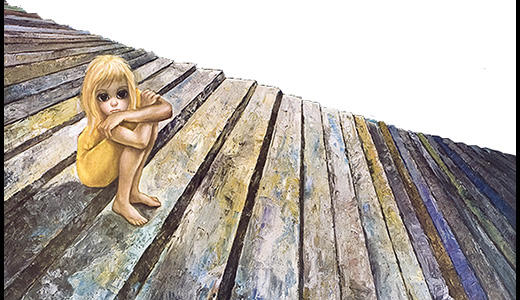
 |
|
Big Eyes Scott Alexander, Larry Karaszewski, and Tim Burton, 2014 #174, 2014 Skandies Landing in 174th place would normally serve as enough of a red flag for me to cross a movie off my to-watch list, but I have long been tickled by the Margaret Keane story, and this take on her story was by the team behind a movie I loved, Ed Wood. Both films have the same gimmick: they take the standard biopic formula about an artist who, in a world of phony careerists, pursues a heartfelt personal vision and overcomes the odds to usher it into the world… and apply it to someone whose art is generally regarded as terrible. The difference is that Ed Wood emerged from obscurity only after his death, discovered by bad movie aficionados who only liked his work ironically; Margaret Keane’s paintings of macrophthalmic ragamuffins quickly became a cultural phenomenon, beloved by a broad swath of the public even as they were reviled by art critics. The twist is that during the big eyes’ heyday, everyone thought that the paintings had been done by Margaret’s husband. Walter Keane was an energetic self-promoter who raced around the country building a market for “his” artwork, but even his friends later had to admit that they’d never actually seen him paint. It later came out that for years he had bullied his wife, who had been painting big-eyed waifs since she was a child, into spending up to sixteen hours a day at their house churning out new material. After their divorce, Margaret asserted her authorship of the paintings, culminating in a courtroom battle in which the judge declared that the question would be settled via an immediate showdown. The two Keanes were presented with identical art supplies and given an hour to paint. Walter claimed that a sudden flare-up of a shoulder injury made it impossible for him to begin his painting. Margaret produced an archetypal big-eyes painting in 53 minutes. That such a dramatic moment actually happened in real life should be an alley-oop for a filmmaker, but the showdown sequence in Big Eyes is oddly lacking in catharsis. The whole movie is a little flat—I’ve seen it called an illustrated Wikipedia article, and that seems pretty accurate. I still would have given the movie a mild thumbs-up if not for one thing. Walter Keane was from Nebraska. I’ve heard interviews with him. He sounds like he’s from Nebraska. The filmmakers cast Christoph Waltz to play Walter. Christoph Waltz can’t do an American accent. Or if he can, he doesn’t do one here. He spends the whole movie sounding like he’s wrestling his own larynx to get the words out. That may be fine if you’re playing a Nazi officer or European gunfighter, but if you’re playing a guy from Nebraska it’s a disaster. Throw in all the mannerisms I remembered from the Tarantino movies, and never for a second did I think “that’s Walter Keane”. It was always “that’s Christoph Waltz spraying acting juice everywhere”. Sank the film. As for the paintings: I have a soft spot for a few of them, but for the most part they are indeed painfully cloying. But as tempting as it is to say that Margaret Keane isn’t even working in the same medium as other painters—that she’s doing kitsch and they’re doing art—in watching the movie version of Margaret surround herself with hundreds of variations on her basic theme, I did get to wondering whether the big eyes are categorically different from the work of a lot of artists who are popular today. Margaret Keane found a way to stylize faces and cranked out many iterations of that style. Mark Ryden does the same thing. So does Audrey Kawasaki. You can say that the big eyes are crudely manipulative, tugging at viewers’ heartstrings, but I’m not sure how much more elevated it is to appeal to the audience’s sense of what’s cool or sexy or whatever. I’m just thinking out loud here, but it seems like these films suggest at least four axes along which we can draw a continuum between Art and Not Art:
These two axes are pretty much orthogonal to one another. Combine low skill and low honesty and you get Walter Keane. Combine low skill and high honesty and you get the movie version of Ed Wood, who can’t write a line of dialogue that doesn’t contain some howler, and whose direction is amateurish on a good day, but who puts his soul into every risible speech and botched shot. On the flip side, a lot of recent blockbusters are low-honesty but high-skill. Producers who in the past would have been satisfied farming out their projects to hacks are instead bringing in top talent. Even discerning viewers end up applauding the result. But ultimately the goal of the project was not to bring a piece of art into the world. It was to launch a franchise able to support a line of lunchboxes and Lego sets and theme park rides in order to set the investors up with yachts.
I added this to the mix because it occurred to me that high-skill, high-honesty productions are not necessarily art either. This is where entertainment comes in. Plenty of people get very good at providing forgettable fun, and genuinely care about the work they’re putting in. This in turn raised the question of whether art was better than entertainment, which brought up a fourth axis:
In Big Eyes, a gallery manager turns up his nose at Parisian street scenes and big-eyed urchins, since it’s the ’50s and Abstract Expressionism is in. Many would argue that it takes at least a modicum of skill to paint people and buildings, while no skill is required to paint colored blobs and squiggly lines. But the latter had the prestige. Here, though, I have to double back and poke at the phrase “the culture”. Whose culture? In film, glossy summer blockbusters might have more prestige to mass audiences than Ed Wood’s sci-fi/horror B‑movies; the year’s crop of Oscar nominees might have more prestige to educated audiences than the summer blockbusters; and then you have the cinéastes who roll their eyes at the Oscar nominees and instead trade posts about what’s playing at the arthouse. But those arthouse movies hold no cultural cachet at all to a lot of the summer blockbuster fans. Similarly, while some people buying posters of Keane paintings at their local supermarket might have bought into the prestige of Abstract Expressionism and thought, oh, that stuff is over my head, and this is more my speed… a lot more probably didn’t buy into it at all, scoffing that their kids could paint that crap and the Keane paintings genuinely were better. So I guess that doesn’t leave much ground for agreement. You have to infer from circumstantial evidence how much honesty or cynicism an artist is bringing to a particular work, unless you can somehow see into her soul. People might differ about how personally invested a creator seems to be in a work—and about how much that should matter, if at all. Depth you have to be able to find. A work might seem stupid or baffling the first time around, and completely awesome a few years later, after you’ve become more attuned to the medium: discovering how the meter of a line of poetry reflects the content, say, or following the counterpoint in a symphony. On the flip side, something that seems profound the first time around might strike you as trite once you’re more sophisticated. Plenty of room there for argument about how deep a work is. To judge how much skill was required to create a work, you have to know a little something about the medium. (Hop into a Usenet archive and read the 14-year-olds and 41-year-olds of the 1990s arguing on the comics newsgroups about whether Rob Liefeld or Jack Kirby was the more talented artist.) As for prestige—I remember watching Manhattan back in the ’00s and being struck by how, at least among the social circles represented in this film from 1979, there was a sense that there was such a thing as high culture and an urbane individual was expected to be acquainted with it. That doesn’t really seem to be a thing anymore. Whether the culture has fragmented, as people claimed in the ’90s, or whether it was always fragmented and we’ve only recently started to acknowledge it, the idea that more than a handful of people could ever agree on what is serious art and what is frivolous trash seems like a relic of the past. All in all, I guess what I’m saying is, if you can’t think of a good last line for your article, consider rambling on for another 900 words or so. I dunno—what do you think? Did I leave any axes out?
|
||||||||||||||||||||
 |